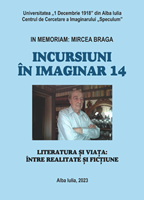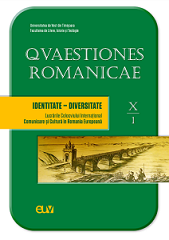Author(s): Alexandru Foitos / Language(s): Romanian
Issue: 14/2023
The present work proposes an applied analysis, by bringing together the Romanian literary avant-garde with the European artistic one, a reunion represented by the text Emil Gayk, a text written by the precursor of the Romanian avant-garde, Urmuz, and the painting Barbarii (The Barbarians) by the German surrealist painter Max Ernst. Both works are specifically related to the First World War, a traumatic experience that leads to specific poetics of avant-garde and modernity, that of the crisis of human representation. Thus, we will pursue a comparative, but also interdisciplinary approach, the selected literary text being subjected to a hermeneutic approach, through a close reading in close connection with the real context of the beginning of the 20th century, while Max Ernst's work will be subjected to an aesthetic analysis, its component elements also reflecting the tragedy and tension of the First World War. The two works reflect, through specific techniques, predominantly surrealist (or, in any case, from the general sphere of the avant-garde), the way in which the modern and avantgarde artist feels this tension caused by the war, so that by the experience of the conflagration, lived directly or indirectly by to the two representatives of the avant-garde, an alienated and reified world is reconstructed, a world of the body crisis, of the sick mind. The irrationality and absurdity of war will be reflected in the avant-garde works of the two representatives, configuring a strong visual dimension and thus a spectacular absurdity of the human body, inspired by the front-line experiences of the European avant-garde artists. Dehumanization and the monstrous, the grotesque, the hybrid, the cadaver, the incongruity of anatomical elements, behavioral deviations and irrational acts, zoomorphism or the mechanization of the human are recurring themes of avant-garde works that highlight this cause-effect relationship between the trauma of war, with the real lived experience, and their mirroring in literary texts (by Romanian avant-garde representatives, such as Urmuz, Tristan Tzara, Ilarie Voronca, etc.) or in paintings (through representatives of modern plastic art and the avant-garde, such as George Grosz, Otto Dix, Max Ernst, etc.). Considering the common experience surrounding the First World War, a moment of amplification of the artistic crisis at the beginning of the 20th century, the two proposed works present a new vision of the alienated modern human, a crisis of the human representation generated by the anxieties and trauma of the war, through which the individual becomes a composite, deformed, sickly creature, made up of heterogeneous elements, a melting point. In this way, those elements of vision, specific to avant-gardes and modernity (as a generic term), which contribute to mirroring the experience of war, will be analyzed. Both works are based on a modern aesthetic vision, nuanced on the basis of avant-garde formulas, considering the themes and motifs they encompass, the style, the construction of the characters, the images and, thus, the predominantly visual dimension, respectively the way in which the narrative discourse is constructed in the case of the text Emil Gayk by Urmuz and the way in which the techniques and images specific to surrealism become complementary in the painting Barbarii (The Barbarians) by Max Ernst. Through an interdisciplinary approach, we can observe how, both in literature and in art, this new perspective on “the human” is proposed, in the context of the crisis of their representation.
More...










